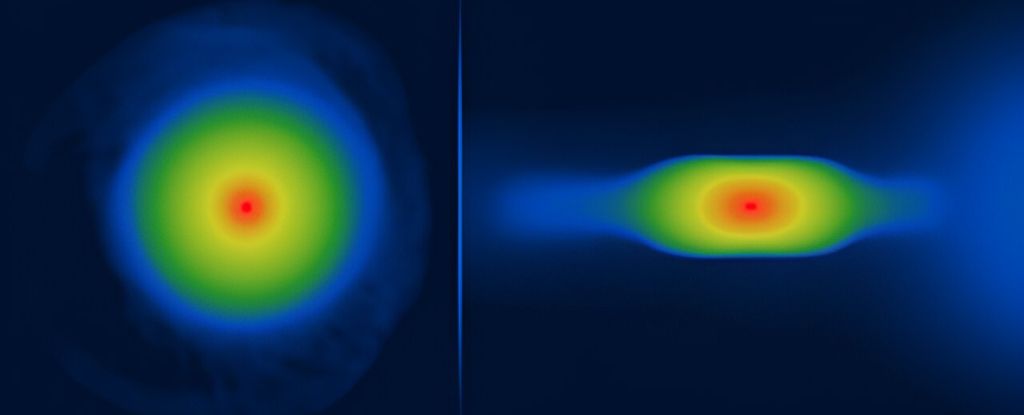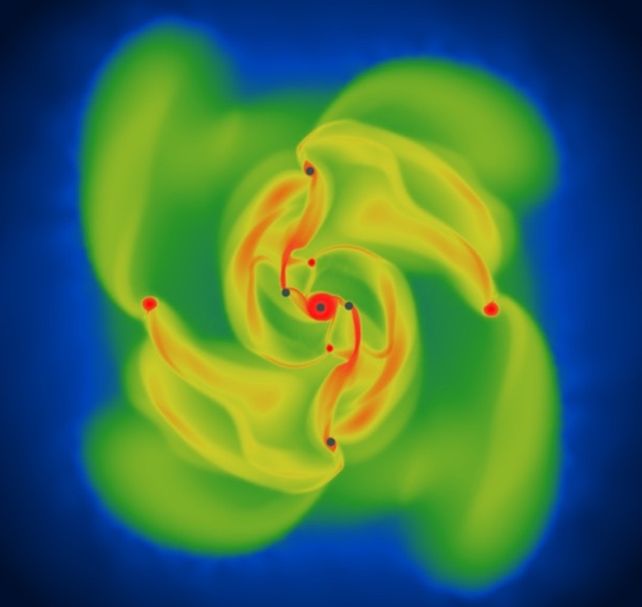Earth Isn’t Flat, But New Theory Suggests Jupiter Might Once Have Been
The formation of planets might not always go the way we picture it in our heads.
New simulations show large planets that form quite far away from their host stars start their lives not as a neat sphere, but more of a flattened disk like a fluffy pancake or an M&M — a shape called an oblate spheroid. As they spin, these protoplanets gradually draw in material, eventually settling into the more familiar round shape of Jupiter or a gobstopper. (Don’t lie, you would eat a bowl of Jupiter.)
The finding arrived at by astrophysicists Adam Fenton and Dimitris Stamatellos of the University of Central Lancashire sheds some light on the myriad different ways to grow a planet, in the turbulent disk of dust and gas that roils around a baby star.
“We have been studying planet formation for a long time but never before had we thought to check the shape of the planets as they form in the simulations. We had always assumed that they were spherical,” Stamatellos says.
“We were very surprised that they turned out to be oblate spheroids, pretty similar to smarties!”
Although we’ve found lots of planets out there in the Milky Way – over 5,500 confirmed to date – it’s not entirely clear how they form. When a star is born, it forms from a clump in a huge, dense cloud of gas and dust in space; that clump collapses under gravity and starts spinning. Material around it forms a disk that spools into the baby star, feeding its growth.
That disk doesn’t all wind up falling onto the star. What’s left over forms the other things that make up a planetary system: the planets, the comets, the asteroids, the moons.
But how does the material in the disk come together? For smaller terrestrial planets like Earth, Venus, Mars, and Mercury, scientists think they are gradually built from the accretion of chunks of rock that stick together and accumulate until you end up with, well, a planet.
For the larger gas giants, scientists believe something called disk instability might occur. This is when the rapidly cooling disk around the star breaks into chunks that condense under gravity and form into planets.
This is an attractive idea, because it can explain planets that are challenging to rationalize under accretion theory, such as planets that are far larger than expected for their star, planets on wide orbital separations, or large planets that form quickly.
Fenton wanted to better understand the process of disk instability planet formation, so he designed and ran complex simulations, tweaking different aspects of the process, such as the gas density, the temperature, and the velocity of the disk.
“It was an extremely demanding computational project requiring half a million CPU hours on the UK’s DiRAC [Distributed Research using Advanced Computing] High Performance Computing Facility,” Fenton says. “But the results were amazing and worth the effort!”
Simulation of four protoplanets forming under disk instability around their star. The planets and star are marked with a black dot, with red representing higher density areas. ( Fenton & Stamatellos, arXiv, 2024 )
Those results revealed that gas giant protoplanets first form a flattened shape as they spin – which, given the centrifugal force involved, and the fact that the protoplanet is still a relatively loosey-goosey collection of matter at that stage, makes sense. Even the well-formed and much more compact planets of the Solar System have centrifugal bulges around their equators.
The simulation also suggests that material accumulates onto the growing protoplanet predominantly at the poles, rather than around the equator.
It’s unclear what the finding means for the core accretion model, but the research does suggest that the properties of a protoplanet embedded in a stellar disk could appear to vary, depending on the viewing angle.
From the side, the pancake shape is more obvious, but from the top, it’s easy to mistake the round shape for a sphere. We’re getting better at spotting these developing planets, so it’s important, the researchers say, to grasp how to interpret what we’re looking at.
The research has been accepted into Astronomy & Astrophysics Letters, and is available on arXiv.
News Related
-
Anyone who’s purchased gift baskets to hand out to loved ones this holiday season might need to find a backup present after the latest food recall that involves festive cookies. Gift basket company Wine Country Gift Baskets just announced that it is voluntarily recalling all gift baskets that feature Acorn Baking ...
See Details:
Recall Just Announced For Popular Cookies Featured In Holiday Gift Baskets
-
LOS ANGELES: Quarterback Jalen Hurts ran in an overtime touchdown to give the Philadelphia Eagles a 37-34 NFL win over the Buffalo Bills Sunday (Monday in Manila) and move them to 10-1 on the season. The Eagles, who lost the Super Bowl to Kansas City last season, trailed at half-time ...
See Details:
Eagles rally past Bills in overtime as Chiefs win
-
Yen Makabenta First word WHILE UN Secretary-General Antonio Guterres and other promoters of the climate emergency are preparing to convene the 28th conference of the parties (COP28) of the UN Framework Convention on Climate Change (UNFCCC) in the United Arab Emirates, starting on November 30 and stretching to December 12, ...
See Details:
Reality bites the green energy agenda
-
Sandigan orders Marcos Sr. pal to pay workers The Sandiganbayan has ordered the enforcement of a July 2023 ruling ordering a Marcos Sr. associate to pay a lumber company’s workers P2.1 million in damages as well as return 60 percent of their company’s shares and pay all unpaid benefits. The ...
See Details:
Sandigan orders Marcos Sr. pal to pay workers
-
DSWD: Shear line, LPA affect 1.2 million people; over 18,000 families evacuated MANILA, Philippines – More than 18,000 families have fled to evacuation centers across flood-affected regions in the country due to the impact of the shear line and low pressure area. Department of Social Welfare and Development (DSWD) gave ...
See Details:
DSWD: Shear line, LPA affect 1.2 million people; over 18,000 families evacuated
-
-
MANILA, Philippines: The entire Luzon, including Metro Manila, is expected to experience isolated rain showers and thunderstorms as the northeast monsoon (“amihan”) and easterlies will be affecting the country over the next 24 hours, the state-run weather agency said on Tuesday. Weather specialist Patrick del Mundo of the Philippine Atmospheric ...
See Details:
Rain showers, thunderstorms over Luzon, including Metro Manila — Pagasa
-
Attention, Naruto fans! You can soon watch the famous anime’s live-action adaptation as it finally has a confirmed writer. According to a Variety report, the beloved manga and anime series is set to head to big screens for its live-action adaptation under Lionsgate. It will be written by Tasha Hao, ...
See Details:
'Naruto' live-action film adaptation is in the works
-
Attention, Naruto fans! You can soon watch the famous anime’s live-action adaptation as it finally has a confirmed writer. According to a Variety report, the beloved manga and anime series is set to head to big screens for its live-action adaptation under Lionsgate. It will be written by Tasha Hao, ...
See Details:
NASA Highlights Stingray Nebula
-
Attention, Naruto fans! You can soon watch the famous anime’s live-action adaptation as it finally has a confirmed writer. According to a Variety report, the beloved manga and anime series is set to head to big screens for its live-action adaptation under Lionsgate. It will be written by Tasha Hao, ...
See Details:
Manila's Lagusnilad underpass opens
-
Attention, Naruto fans! You can soon watch the famous anime’s live-action adaptation as it finally has a confirmed writer. According to a Variety report, the beloved manga and anime series is set to head to big screens for its live-action adaptation under Lionsgate. It will be written by Tasha Hao, ...
See Details:
China probes debt-ridden financial giant
-
Attention, Naruto fans! You can soon watch the famous anime’s live-action adaptation as it finally has a confirmed writer. According to a Variety report, the beloved manga and anime series is set to head to big screens for its live-action adaptation under Lionsgate. It will be written by Tasha Hao, ...
See Details:
China's VUCA situation
-
Attention, Naruto fans! You can soon watch the famous anime’s live-action adaptation as it finally has a confirmed writer. According to a Variety report, the beloved manga and anime series is set to head to big screens for its live-action adaptation under Lionsgate. It will be written by Tasha Hao, ...
See Details:
Unraveling the mystery that is diabetes
-
Attention, Naruto fans! You can soon watch the famous anime’s live-action adaptation as it finally has a confirmed writer. According to a Variety report, the beloved manga and anime series is set to head to big screens for its live-action adaptation under Lionsgate. It will be written by Tasha Hao, ...
See Details:
Bangladesh's nuke plant is not going to steal PH investments
OTHER NEWS
ALIW Awards Foundation Inc. President Alice H. Reyes has released the names of finalists for the 2023 Aliw Awards to be presented on Dec. 11, 2023, at the Manila Hotel ...
Read more »
WhatsApp Web gains the feature of single-view photos and videos (Photo: Unsplash) The WhatsApp Web, the desktop version of the popular messaging app from Meta, has received an update allowing ...
Read more »
Young athletes’ time to shine in Siklab Awards MANILA, Philippines — The future heroes of Philippine sports will be honored during the third Siklab Youth Sports Awards on Dec. 4 ...
Read more »
Graphics by Jannielyn Ann Bigtas A local government official said Monday that five to 10 barangays in Northern Samar are still isolated following the massive flooding in the area last ...
Read more »
DyipPay app lets you pay jeepney fare, book tricycles “Barya lang po sa umaga.” Everyone who rides jeepneys knows this rule: it may not be an actual law, but it’s ...
Read more »
Updated In-Season Tournament Bracket ahead of pool play finale Tuesday will mark the last day of pool play for the inaugural NBA In-Season Tournament. From there, six first-place teams and ...
Read more »
PCG forms teams for maritime emergency response MANILA, Philippines — Recent incidents of fishermen lost in the waters off Southern Tagalog have prompted the Philippine Coast Guard (PCG) to form ...
Read more »


